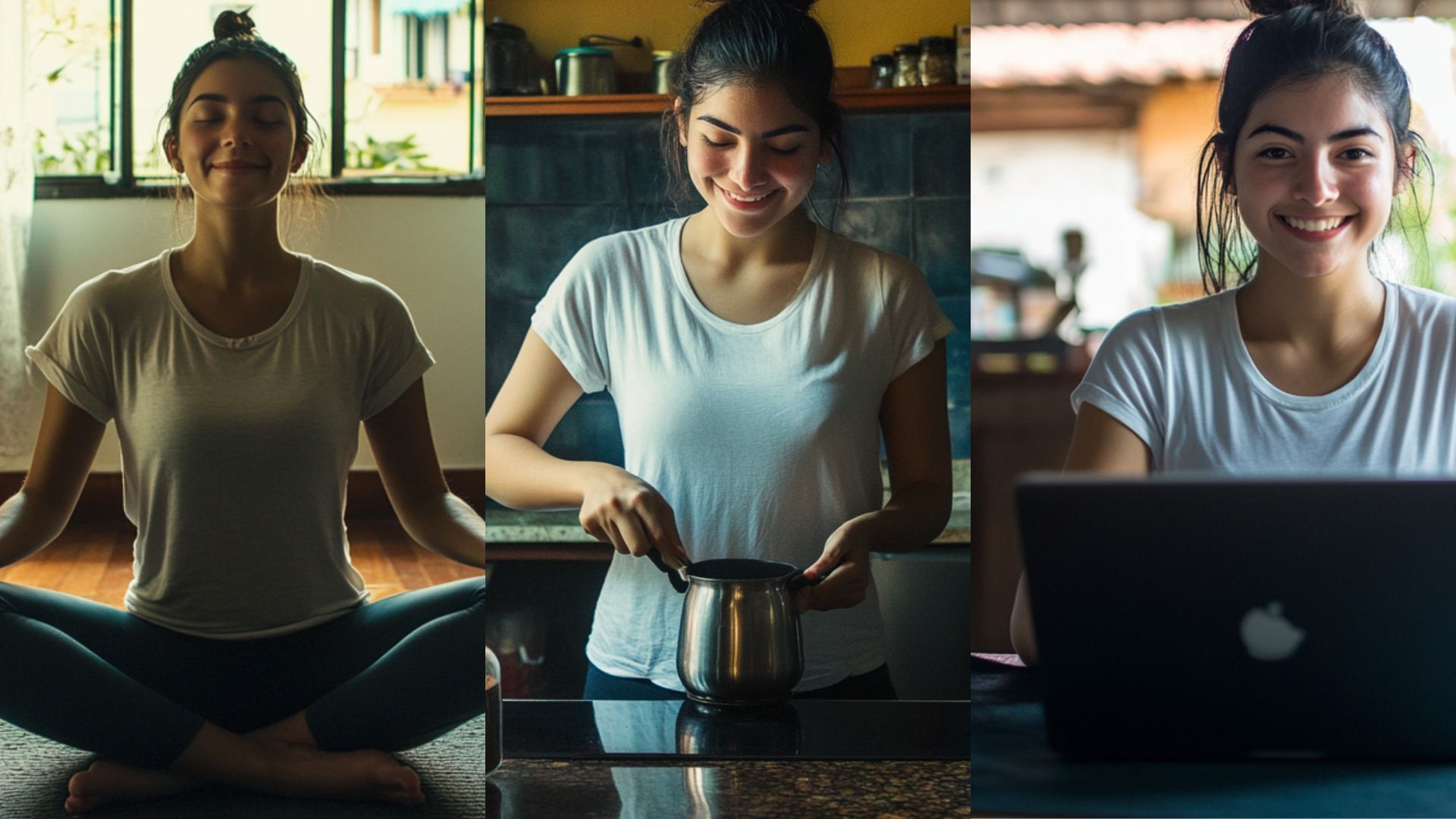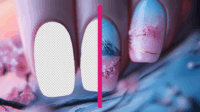In this article:
- Start with a minimum-viable morning routine
- Feed your visual inspiration bank first thing
- Optimize your workspace for creative flow
- Plan your design projects strategically
- Prime your creative mindset
- Sharpen your design skills deliberately
- Prioritize personal design projects
- Connect with the design community
- Set client communication expectations
- Practice physical wellness for creative stamina
- Keep it adaptable and sustainable
- Final thoughts on designer morning routines
As a graphic designer, your morning routine can make or break your entire day. I’ve spent over a decade working with freelance designers and running my own creative business, and I’ve learned that how you start your day directly impacts your creative output, client interactions, and overall business success.
But let’s be honest—mornings can be tough. Between hitting the snooze button, battling traffic, and desperately seeking that first cup of coffee, it’s easy to start your day feeling drained before you’ve even opened your design software.
The good news? A thoughtfully crafted morning routine specifically designed for graphic designers can transform your productivity, spark your creativity, and even help you land more clients. These aren’t just generic productivity tips—they’re tailored specifically for the unique challenges and opportunities we face as designers.
I’ve experimented with countless morning routines throughout my career and coached hundreds of freelance designers on optimizing their workflows. In this article, I’ll share my most effective strategies to help you create a designer-specific morning routine that actually works.
Let’s dive in.
Start with a minimum-viable morning routine
Just like I advise designers to start with a minimum-viable portfolio, I recommend the same approach for your morning routine. Many designers never implement a morning routine because they try to adopt too many habits at once.
Instead, ask yourself: “What’s the least I can do every morning to make a meaningful impact on my design work?”
Maybe that means spending just 15 minutes on creative exercises before checking email. Or perhaps it’s setting aside time to plan your design projects for the day before diving in. Whatever feels most crucial yet manageable for you, start there.
Remember, you can always build on this foundation later. Having a simple routine you actually follow is infinitely more valuable than an elaborate one that exists only in your imagination.
Feed your visual inspiration bank first thing
As designers, our creative output depends on our visual input. Your morning presents a prime opportunity to fill your inspiration bank before withdrawing from it all day.
Take one design-focused photo each morning
This practice serves two purposes: it trains your designer’s eye to find beauty in everyday surroundings and creates a personal catalog of visual inspiration.
Challenge yourself to capture one compelling image each morning—whether it’s interesting typography on your commute, unique color combinations in nature, or intriguing patterns in architecture. Over time, you’ll build an impressive collection of original visual inspiration while simultaneously training yourself to see the world through a designer’s lens.
I know a designer who landed a major branding project simply because she shared her morning photo series on Instagram, which caught a prospective client’s attention. This simple habit became both a creativity booster and a marketing tool.
Curate your visual fuel for the day
Before diving into client work, spend 10 minutes deliberately seeking visual inspiration tailored to your projects. This isn’t aimless scrolling—it’s strategic research.
If you’re working on a packaging design project, perhaps browse specialized packaging design accounts or websites. Working on a minimalist logo? Seek out examples of exceptional negative space usage or masterful typography.
The key is being intentional rather than random. Tools like Pinterest, Behance, or even a well-organized bookmark system can help you efficiently gather project-specific inspiration.
Optimize your workspace for creative flow
Your physical environment significantly impacts your creative thinking. Take a few minutes each morning to set up your workspace in a way that facilitates your best design work.
Declutter your physical and digital workspace
A cluttered environment leads to cluttered thinking. Take 3-5 minutes each morning to:
- Clear your desk of yesterday’s coffee mugs, random papers, and other distractions
- Close unnecessary browser tabs and organize your desktop files
- Arrange your tools and materials for easy access
Think of this as setting the stage for your creative performance. Just as a chef prepares their mise en place before cooking, a designer should prepare their creative environment before designing.
Calibrate your design tools
Few things are more frustrating than discovering color inconsistencies or software glitches midway through a client project. Take a moment each morning to:
- Ensure your monitor’s color calibration is accurate
- Check that your design software is updated
- Verify that your drawing tablet or other tools are functioning properly
This simple technical check can prevent headaches later in the day and ensure your designs look exactly as intended.
Plan your design projects strategically
Having a clear plan transforms your productivity as a designer. Rather than reactively jumping between projects, use your morning to establish intentional direction.
Identify your One Big Design Task (OBDT)
Most designers have multiple projects running simultaneously. The key to making meaningful progress is focusing on one significant design task each day.
Every morning, ask yourself: “What’s the one design task that would make the biggest impact on my business today?”
Perhaps it’s completing that logo concept for your biggest client. Maybe it’s finalizing a website mockup with an approaching deadline. Or it could be creating that case study for your portfolio that will help you attract new business.
Whatever it is, write it down prominently and commit to completing it before anything else. This simple practice prevents you from getting lost in busy work while neglecting the projects that truly drive your design business forward.
Map your design workflow
Once you’ve identified your OBDT, take 5 minutes to map out the specific steps needed to complete it. Breaking down complex design projects into smaller, actionable steps makes them far less daunting.
For example, if your OBDT is “Create brand style guide for Client X,” your workflow might include:
- Review client questionnaire responses and feedback
- Finalize color palette selections
- Create typography hierarchy examples
- Design logo usage guidelines
- Compile mockups showing brand applications
This granular approach is particularly effective for design work, which often involves multiple interconnected elements and considerations.
Prime your creative mindset
Your mental state dramatically affects your creative output. Use your morning to deliberately cultivate a mindset conducive to design excellence.
Find or create a visual quote for the day
Words have power, but as designers, visuals often speak to us more profoundly. Each morning, find or create a visually compelling quote that resonates with your current design challenges or aspirations.
You might design it yourself as a quick creative warmup exercise, or find inspiration from other designers who share typographic quotes. Save it as your phone background or pin it near your workspace.
This practice serves as both a creative exercise and a mindset anchor throughout your day. On days when client revisions are overwhelming you, a visual reminder of why you became a designer can be incredibly grounding.
Practice deliberate visualization
Before opening your design software, spend 2-3 minutes visualizing success on your current projects. See yourself creating exceptional work, receiving enthusiastic client feedback, or showcasing the completed design in your portfolio.
This might sound too “woo-woo” for some, but research consistently shows that visualization techniques can improve performance across various fields. For designers specifically, this practice helps overcome creative blocks by pre-emptively addressing doubts and building confidence.
Sharpen your design skills deliberately
The most successful designers make skill development a daily habit rather than an occasional pursuit. Your morning offers the perfect opportunity for focused learning before client demands take over.
Learn one new design technique or shortcut
Commit to learning just one new thing each morning—whether it’s a keyboard shortcut in your design software, a new typography technique, or a color theory principle.
These small additions to your skill set compound dramatically over time. In one year, you’ll have added 250+ new techniques to your design arsenal, giving you a significant competitive advantage.
This practice transforms professional development from an overwhelming task into an easily manageable daily habit. I recommend keeping a running list of techniques you want to learn and selecting one each morning.
Do a 15-minute design exercise
Just as athletes warm up before a game, designers benefit from creative warm-up exercises. Dedicate 15 minutes each morning to a design-specific practice session unrelated to client work.
This might include:
- Recreating a logo you admire to understand its construction
- Experimenting with a new color palette
- Practicing letterforms or illustrations
- Creating abstract compositions using only basic shapes
These exercises keep your fundamental design skills sharp while allowing you to experiment without client constraints. Many designers find that these morning creative sessions lead to innovative techniques they later incorporate into client projects.
Prioritize personal design projects
One of the biggest regrets I hear from designers is neglecting their personal creative projects and portfolio. Your morning routine can help address this common challenge.
Dedicate time to your design side project
Before client work takes over, spend 20-30 minutes advancing a personal design project. This might be developing your own brand, creating a passion project for your portfolio, or working on a design product you hope to sell.
The compound effect of this daily commitment is remarkable. In just one month of weekday practice, you’ll have invested 10+ hours in your personal design work—often enough to complete a significant project that can elevate your portfolio and attract better clients.
I’ve seen countless designers transform their careers by consistently prioritizing personal projects that demonstrate their true capabilities, rather than only showcasing client work that may have been constrained by budgets or timelines.
Update your design portfolio incrementally
Instead of facing the overwhelming task of completely revamping your portfolio every few months, use your morning routine to make incremental improvements.
This might mean:
- Adding one process photo from yesterday’s project
- Writing a single paragraph for a case study
- Updating your bio or services description
- Optimizing one portfolio image for better loading speed
These small efforts accumulate into a consistently updated portfolio that accurately reflects your current skills and projects. Moreover, this approach eliminates the common portfolio paralysis that prevents many designers from showcasing their work effectively.
Connect with the design community
Design can be isolating, especially for freelancers. Your morning routine can help you stay connected to the broader design community and build valuable professional relationships.
Engage meaningfully with fellow designers
Spend 10 minutes each morning connecting with other designers—not just passively scrolling through design social media, but actively engaging in ways that build relationships.
This might include:
- Leaving thoughtful comments on a designer’s work you admire
- Participating in design forums or Slack communities
- Sending a quick message to a design colleague
- Sharing an insightful resource with your network
These small interactions foster a supportive professional community while potentially opening doors to collaborations, referrals, and mentorship opportunities.
Schedule one coffee chat per week
Use your morning planning time to schedule at least one virtual or in-person coffee chat with another designer or creative professional each week.
These informal meetings provide valuable opportunities to exchange ideas, discuss industry trends, and build relationships that can lead to project referrals. They also combat the isolation many designers experience, particularly those working freelance.
By scheduling these during your morning routine, you ensure they actually happen rather than being perpetually postponed.
Set client communication expectations
How you handle client communications first thing in the morning sets the tone for your professional relationships and establishes healthy boundaries.
Define your client response windows
Instead of immediately responding to every client message, use your morning to establish when and how you’ll address client communications throughout the day.
Consider blocking specific times for client emails and calls rather than allowing them to interrupt your creative flow throughout the day. This structured approach allows you to be responsive to clients while protecting your focused design time.
Communicate these windows clearly to clients so they know when to expect responses, which actually increases their confidence in your professionalism rather than diminishing it.
Prepare for client meetings strategically
If you have client meetings scheduled, use part of your morning routine to prepare deliberately rather than diving in unprepared.
Review project briefs, prepare specific questions, and gather relevant design examples or progress updates. This focused preparation dramatically improves the productivity of client interactions while positioning you as a thorough professional.
Practice physical wellness for creative stamina
Design work is surprisingly physical—from the strain of hours at the computer to the mental fatigue that comes with creative problem-solving. Your morning routine should include elements that support your physical wellbeing.
Do designer-specific stretches
Incorporate a 5-minute stretch routine specifically targeting the areas most affected by design work:
- Wrist and finger stretches to prevent carpal tunnel
- Neck and shoulder exercises to counteract hunching
- Eye exercises to reduce digital eye strain
These targeted movements can prevent the physical ailments that commonly plague designers while preparing your body for the physical demands of your work.
Create a deliberate hydration and nutrition plan
Your cognitive function—including creative thinking and problem-solving—is directly impacted by hydration and nutrition. Use your morning to set up a deliberate plan for both.
Prepare a large water bottle at your desk and plan strategic, energy-sustaining snacks to maintain your creative energy throughout the day. Many designers find that their creativity wanes in the afternoon simply due to dehydration and blood sugar fluctuations, which are easily preventable with some morning planning.
Keep it adaptable and sustainable
The most effective designer morning routines aren’t rigid—they evolve with your changing projects, life circumstances, and professional goals.
Review and adjust weekly
Take 10 minutes each Friday morning to assess what’s working in your routine and what needs adjustment. Perhaps you need more time for skill development during a slow client period, or more focus on client communication during a busy season.
This regular reflection prevents your routine from becoming stale or irrelevant to your current design needs.
Start with just three elements
If implementing all these suggestions feels overwhelming, remember the minimum-viable approach. Select just three elements from this article that seem most valuable for your specific design practice and focus on those.
Once those become habitual, you can gradually incorporate additional elements. A simple routine you actually follow is infinitely more valuable than an elaborate one you abandon after a week.
Final thoughts on designer morning routines
Your morning routine as a graphic designer isn’t just about productivity—it’s about creating the conditions for consistent creative excellence and business growth.
The designers I’ve coached who implement intentional morning routines report not only improved creative output but also better client relationships, more efficient workflows, and greater satisfaction with their design careers.
Remember that the goal isn’t perfection but progress. Some mornings will inevitably be chaotic, and that’s okay. What matters is having a baseline routine you return to consistently, one that supports both your creative practice and your business goals as a designer.
By starting each day with deliberate attention to your creative process, professional development, and business strategy, you set yourself up for long-term success in an increasingly competitive design landscape.
What morning routine elements have transformed your design practice? I’d love to hear your experiences in the comments!



